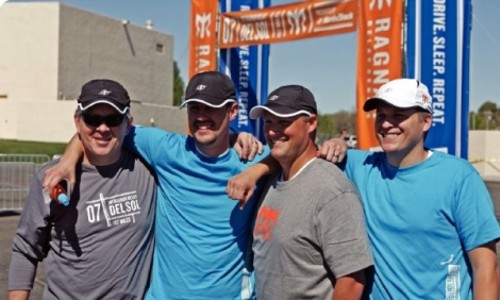They were in college when this career idea was hatched—or more appropriate, running, through their minds.
Tanner Bell and Dan Hill now find themselves not only having turned the Ragnar Relay Series into a way of life for many in Utah and beyond, it has become their livelihood—a full-time gig, complete with a staff that has quadrupled in the past 18 months and is also checking up on what’s turned into 10 running races. Next season will be the first year since 2004 that there hasn’t been expansion.
Yet, don’t confuse that with stagnancy.
“As [ubiquitous] as we appear to be around here, I think we’re just scratching the surface nationally,” says Bell, from his new Farmington office. Ragnar intends on getting there, constantly traveling the country and looking for ways to expand.
It’s beautiful work, if you can dream it. There are the basic census calculations to be done in looking at market sizes and running-population bases. From there, the screening process involves finding a route, which means searching for about 170 miles of roads from start line to the finish. It is much like an architect seeing a plot of land and imagining a golf course. “It’s a lot of driving and researching on Google maps,” Bell says, noting that staff enjoyed a trip to Virginia. “The toughest challenge is, for the most part, we don’t close the roads, so you have to look at those logistics, as well.” After the Nov. 20-21 Clearwater-to-Daytona Beach event in Florida, the race series can catch its breath and focus on next year.
The signature event is still the Wasatch Back, which is scheduled in June from Logan to Park City. It exploded to 735 teams in 2009, with most being made up of 12 runners (some hearty crews will use just one van, six people) meandering nonstop for 24 hours or more through all weather conditions.
Just drive around town these days, and it’s hard not to find someone with the distinctive Ragnar sticker on his or her car. And it’s all types—everyone from PowerBar fiends to soccer moms, and some a la carte exercisers who think ketchup counts as a vegetable. Take a look at any of the company’s races, and they appear exclusive—who really thinks they can run six miles at 3 a.m.?—but word of mouth created by sheer adrenaline and sincere camaraderie has quickly spread, and the brand name is flourishing.
As proud as Ragnar is of its growth—it added seven races in the past two years and jumped to 23 staffers from six—its key is retention. Bell says there’s a 100 percent return from year to year by at least one member from each team. “It is a bonding experience that only past participants can understand, and it is the reason why they come back year after year,” co-founder Hill says.
But with success has come, for many runners, some setback. Ultra-distance running is inherently dangerous, based on the physical demands. Just this year, three experienced, capable runners died during the Detroit marathon. Ragnar had its first such sorrow in a more numbing way when Jeremy Kunz, 33, of Kamas, was struck and killed during the Las Vegas-area race on Oct. 10 by an allegedly speeding, drunken driver at about 5 a.m. At the time, Kunz was off to the side on what Bell deemed a “safe stretch of road,” which included a bike lane and wide shoulder. Bell describes it as an “unbelievably tragic” circumstance.
Ragnar sent out an e-mail to its mailing list (mostly past runners) to describe a variety of ways to contribute to the Kuntz family foundation. As it does annually, Ragnar is taking a look at safety measures and also intends to fund-raise at future events.
Kunz was helping out a runner who required nourishment and encouragement. “On the course, we all look out for each other and feel a kinship that few may understand if they haven’t personally experienced it,” regular event participant Laurie Pratt said in an online eulogy of Kunz.
It’s a passion that comes from all types, beginning with a couple of guys who concocted a long-running aspiration. “I think when we started it, we really did it hoping it would be something we were passionate about. We wanted it to be work that everybody dreams about, because they love doing it,” Bell says. “We were hoping it could be full-time, of course, maybe have an impact on the state and become something all sorts of people would really enjoy because of the outdoors culture we have here.”
More by Jason Franchuk
-
Skiing After Dark
Moondancing: Sundance Resort joins the local after-dark ski party.
- Feb 24, 2010
-
Kicking smoking empowers man to take on mountain
Zack Ralphs: Scaling Mount Kilimanjaro
- Jan 13, 2010
-
Winter Tennis
Winter Serve: Liberty Park’s bubble-topped tennis courts keep the love going year-round.
- Nov 4, 2009
- More »



